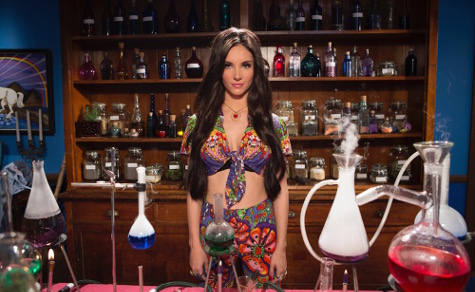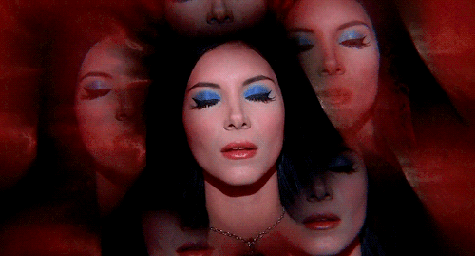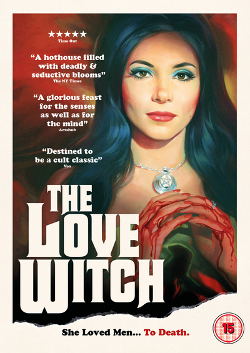
One sign of a worthwhile film is that it can be experienced on different levels. This is the case with The Love Witch, the sexy horror-thriller movie that was released in late 2016 and is still making its debut in theaters in parts of the globe now.
One aspect of The Love Witch that a viewer can focus on is simply its story. A feminist study of relations between the sexes, the tale follows the romantic/sexual exploits of Elaine, an alluring and powerful youngish woman who practices witchcraft. Elaine’s heart was crushed when her former husband left her (he later died under suspicious circumstances), and now she’s looking for a new man. She leaves San Francisco and starts a new life in a Gothic apartment in a smaller California city.
Elaine has a forceful presence, you-can’t-stop-staring-at-her looks, and an enchantingly mysterious personality. She’s the kind of woman who makes most men salivate and puts most other women on their defenses. And yet, Elaine is mentally unbalanced and not in control of her emotions; when she uses potent witchy concoctions on the men she meets and goes for, things get out of control for both her and the guys.
Another way to take in The Love Witch is as a set of sensory pleasures. The film looks gorgeous, and its visuals and sounds have a mesmerizing effect on the viewer. Elaine’s perfectly applied eye shadow and lipstick, the eye-catching costumes, Elaine’s visually arresting supernatural art pieces and witchcraft works, the striking set designs, the haunting harp music played in a club scene along with other effective sound pieces, the hallucinatory visual effects … it’s a two-hour sensory orgy.

Alfred Hitchcock said, “If it’s a good movie, the sound could go off and the audience would still have a perfectly clear idea of what was going on.” This is true of The Love Witch, and what’s also true is that, although you’d be missing out on the musical aspects, you could watch this film from start to finish with the sound off and walk away fully pleased and with your senses heightened.
Finally, The Love Witch can be enjoyed if only for its sexual aspects. Even in the scenes where she’s not in intimate actions with a guy, Elaine’s erotic presence is so strong that watching the movie can have you in a state of near-constant titillation.
The film is a challenge when it comes to definition and classification. Reviewers of The Love Witch spend a lot of time trying to work out whether to think of it as a parody of, or tribute to, a variety of cinematic genres and styles, ranging from British Technicolor horror titles from the 1960s to ‘70s Italian horror fare to Russ Meyer’s soft-core sex melodramas to other areas within the camp/cult/exploitation world of films, particularly from the ‘60s and ‘70s.
Asked if she ever longs for people to experience her film at face value without attempting to classify it or relate it to other movies, The Love Witch’s writer-director-producer Anna Biller reflects:
I really do wish that viewers would watch The Love Witch innocently. It’s the only way to really understand it. I constructed the film starting from story, theme and character, and I designed and directed it according to my own muse. Cinephiles who have watched all of the movies that I’ve watched get the “true” references, but if someone’s seen that much cinema they will also know that it’s an original film and not a copy of any film from any period, especially not the schlock films of the ‘60s and ‘70s which had weak scripts. When they say “style over substance,” it just means the movie went over their head.
Some of the supporting actors of The Love Witch put on strong performances, particularly Laura Waddell, who plays the closest thing Elaine has to a female friend, and Jeffrey Vincent Parise, who portrays one of Elaine’s lovers. But really, this feature is a vehicle for Samantha Robinson in her role as Elaine.
Her looks are only one part of what makes her such a force on the screen. Her voice, which is hypnotizing in its sensual tones, is another factor. And then, there are all of her commanding facial expressions—whether it’s her icy staredowns, come-hither seductive glances, fixated expressions when she’s working on her paintings or potions, or eyeshadow- and lashes-powered blinks. She’s the character around which all the others revolve, and it’s her captivating impact that endows the movie with much of its trance-inducing look and feel. Her dualities of being domineering-yet-vulnerable and decisive-yet-reckless give depth to both her character and the film in general.
Biller, who worked closely with Robinson to prepare her to play Elaine well before shooting on the film got underway, explains why she thought Robinson was the right fit for her lead character:
The first thing I noticed about Samantha was her voice—resonant, perfect diction, the voice of a theatrically trained actress. She has an air of self-possession that is quite unusual for someone her age; she almost reminded me of Marlene Dietrich in the way she was so blasé about the role. She did a fantastic dance audition, sexy and cold at the same time. Then we had a private meeting and I watched her face. I imagined it under the lights, watched her facial expressions, how animated her face was. Every emotion shows on her face. It was the face of a star, a cinematographer’s dream. She also thinks like me—we both approach material intellectually. So I knew she’d be fun to work with.
 Through Elaine, Biller explores the contrasting ways men and women approach romantic relations as well as the ways others respond to a woman who carries provocative sexual energy, and she does all of this from a feminist perspective. Sometimes she probes these matters with a sense of humor, other times with over-the-top melodramatic scenes and bits of dialogue, and still others times it comes across in a more straight, dramatic way. The Love Witch could be seen as the offbeat film enthusiast’s version of a chick flick or date movie—that is, if you like your chick flicks or date movies to include aspects such as occult rituals, bloody death scenes, brainfuck visual effects, and the like.
Through Elaine, Biller explores the contrasting ways men and women approach romantic relations as well as the ways others respond to a woman who carries provocative sexual energy, and she does all of this from a feminist perspective. Sometimes she probes these matters with a sense of humor, other times with over-the-top melodramatic scenes and bits of dialogue, and still others times it comes across in a more straight, dramatic way. The Love Witch could be seen as the offbeat film enthusiast’s version of a chick flick or date movie—that is, if you like your chick flicks or date movies to include aspects such as occult rituals, bloody death scenes, brainfuck visual effects, and the like.
Because of its eye candy appeal, The Love Witch is a film that is ideally viewed on a big screen. And it seems ripe to be one-half of a double feature, preferably in a vintage theater. Queried as to which titles she would like to see her creation paired with on a twin bill, Biller provides an intriguing shortlist:
Leave Her To Heaven (1945)
Marnie (1964) or Vertigo (1958)
Gertrud (1964)
Bell, Book, and Candle (1958)
Peau D’ane (aka Donkey Skin) (1970)
The Locket (1946)
Inauguration of the Pleasure Dome (1954)
Brian Greene writes short stories, personal essays, and reviews and articles of/on books, music, and film. His work has appeared in 25+ publications since 2008. His pieces on crime fiction have also been published by Noir Originals, Crime Time, Paperback Parade, The Life Sentence, Stark House Press, and Mulholland Books. Brian lives in Durham, North Carolina.
His writing blog can be found at: http://briangreenewriter.blogspot.com. Follow Brian on Twitter @greenes_circles
